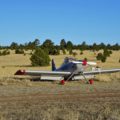Saturday morning was beautiful here in New Mexico. Rain showers had passed thru overnight. There was lots of moisture on the ground (for the desert) and even some still falling from the sky.
A perfect opportunity to do some sight seeing!
I needed to do some video camera testing so I strapped on the cameras and went flying.
I wanted to experiment with the GoPro image stabilization, GPS data recording, and standard view vs. wide angle view.
The following is the result. The sights were so great, I had to make a video to share. Hope you enjoy it!
The results of my testing…
I don’t care for image stabilization – at least while flying. It seems to try a little too hard and results in jerky motion from time to time. It seems to be related to turbulence – or the aircraft experiencing bumps in the air.
The GPS data superimposed on the video is pretty neat – particularly the groundspeed. The G-force meter is a little odd. It starts at zero G – which is not accurate. Zero G is weightless. So, add one to the numbers shown on the video.
Wide angle vs. normal angle? I’m not sure yet. It may depend on what is being filmed. For maximizing the sightseeing, wide angle is certainly the way to go. For particular operations, like a takeoff/landing, it seems that standard angle is better. Still looking for input on what others think.




Loved it! Especially the long range views of the entire skyline! Parts of the terrain are so rugged, and others…like a desert! It must feel so freeing to be up there in the sky – just you & God!
Thanks Crystal! Yeah, getting to fly out here is pretty special!!
Flying through the valleys and canyons remind me of the movie Star Wars. I hope you are being careful. It looked very dangerous to me.
Hi Roger,
This is never an easy topic. To define some terms, the opposite of “dangerous” is “safe.” Many people like to talk about safety and things being safe. Obviously, main stream media has been all over it this year. It is discussed as if it is something to be achieved. In my opinion, being safe is an illusion.
https://www.psychologytoday.com/us/blog/the-second-noble-truth/201802/security-is-illusion
It seems to me that fear (the perception of danger) is a learned emotion. It may be learned from previous experiences but more commonly it is learned from our culture. Snakes and spiders are dangerous, flying an aicraft is dangerous, riding a bicycle is dangerous, and so forth. More interesting to me is that our culture teaches us that drinking alcohol, eating potato chips, and sitting around the house are all safe activities – yet that is false. The three leading cause of preventable death in the USA are related to those things that are “safe.” The world does not want people to know how dangerous riding in a car is – that would wreck the auto industry. Think about 30,000+ deaths per year and over two million injuries – every year. Yeah, that sounds REALLY safe!! They sure don’t want people to know how dangerous alcohol is – physically and emotionally – that would wreck another big industry and people that like to drink would be unhappy. Processed food?? Same thing. What about lawn mowers? They are safe right? Nearly everyone has one. No, sorry, they are very dangerous – many people are injured and even killed by them each year. In spite of that; people are not screaming about “lawn mower control.” Why not? It is culture and has nothing to do with reality, IMO. Culture decides what is “dangerous” and what is “safe” and that decision is not based on facts or reality.
Obviously, risk mitigation is important – one must manage their risks no matter what they are doing. Walking down a set of stairs (hold the handrail), using a table saw (use the guards, a feed stick, etc.), and driving to work (ensure your car is operating correctly, drive defensively, etc.). The same is true of aviation, one must mitigate the risk – equipment inspected and operating correctly, appropriate weather, and (in this particular case) has the area been scouted for obstructions and is the pilot experienced with this type of flying (etc.). No amount of risk mitigation makes an activity safe – it may make it “safer” but that is not safe. How much risk mitigation is enough? How much risk is a person willing to accept? Clearly, this varies from one person to the next and, to a large extent, it depends on what culture decides is “acceptable.” Without any supporting data, our culture has recently decide not wearing a mask is unsafe and taking my kayak out on the lake is unsafe. Amazingly, people believe it – because culture (the people making the most noise) tells them so.
Some people are willing to take this risk mitigation further than others. and do absolutely nothing with their lives. In spite of that – they are not safe, they are still at risk. One of my favorite quotes is “Fear is a manipulative emotion that can trick us into living a boring life.” By Donald Miller in his book ‘A Million Miles in a Thousand Years.’
So, was this flight dangerous? The weather was perfect, the aircraft was operating in perfect condition, the pilot has spent hundreds of hours operating in that exact situation/environment and the route of flight was very familiar. In my opinion, no, it was not dangerous but it was certainly not without risk – just like every other activity in life. Could something unforeseen/unexpected have happened? Certainly. But that is ALWAYS the case with EVERYTHING. For example, making a quick run to the hardware store? I’d suggest kissing your wife and telling her that you love her – it may be the last time you get the chance – who knows what may happen – car accident, fall down the steps, etc…